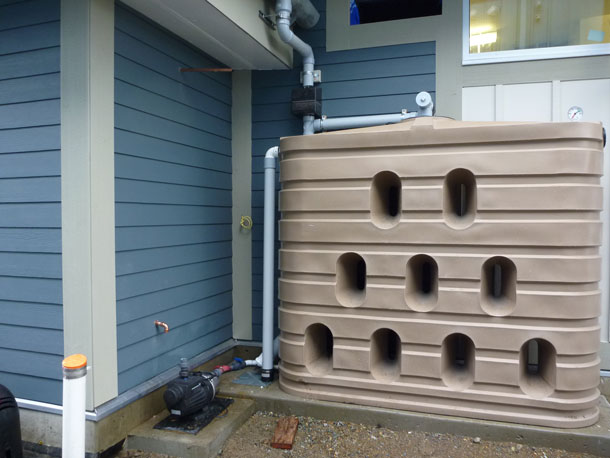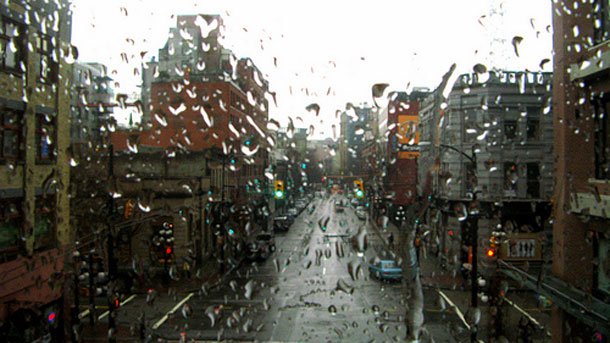DANGER: Drinking this toilet water could be hazardous to your health.
That's the message required above every rainwater-flushing toilet installed at Vancouver's Olympic Village, where water is collected from the roof, stored in a giant holding tank, and pumped as needed for each flush.
The sign is necessary, because bringing rain indoors breaches a fundamental orthodoxy of the North American plumbing world: behind the walls, pipes carrying potable municipal water mingle with those carrying potentially unsanitary rain. On paper, building codes for Vancouver and elsewhere in B.C. do not currently allow the practice of indoor rain water plumbing. In a post-Walkerton regulatory environment, there is immense discomfort on the part of building inspectors at the prospect of mixing private and public water supplies. (See sidebar.)
In spite of this, there are about 25,000 rain water capture systems operating across B.C. today -- used to water lawns and crops, flush toilets and provide drinking water for people and livestock. There are about 5,000 rain systems on Vancouver Island and the Gulf Islands alone, in areas where seasonal droughts and dodgy well water make it a necessity.
As municipalities and cities explore ways to work with the deluge of water that falls from the sky (more than a metre of rain typically falls annually in Vancouver), the most promising use will be for irrigation of lawns and gardens in the near future. This could be good and bad.
"I have a worry that rainwater is starting to get trendy," says Bob Burgess, a B.C. rainwater harvesting pioneer and founder of The Rainwater Connection which designs and builds all sorts of rain capture systems. "More and more people are doing it, and doing terrible jobs of it. It may not be too long before we have our little Walkerton for rainwater."
Looking to the skies
A basic rain harvesting system captures water from a roof and channels it to a storage tank, where it is then pumped to where it is needed. Along the way, the rain undergoes any number of different filters and cleaning methods depending on the end use: to make it potable for drinking, it will require filtration and any combination of UV sanitizing and chlorine-injection; water strictly for watering plants will be cleaned less.
Big municipal fleets are among the early adopters: White Rock currently washes some of its trucks with rain, as does Vancouver; the Regional District of Nanaimo captures rain off two large Parksville recycling transfer buildings and uses it to wash their interior concrete floors.
Commercial greenhouses in places like Delta and Langley have already taken rainwater recycling to a high art: many operations capture and use rain for watering, then continually recapture from the soil, filter and reuse.
Toilet flushing with rain is more complicated, often requiring a separate indoor plumbing system to move it within the building, as well as time-consuming consultations with municipal building officials to get approval. (See sidebar.) Such projects often occur in big "green" building developments like the Olympic Village. Developers often earn points toward LEED certification for such water conservation measures, providing the incentive to go through all the trouble.
Then there are those who use rain water out of dire necessity -- usually for drinking. As early as the 1960s, farmers in the Lower Fraser Valley and on Vancouver Island started to notice their groundwater was being contaminated by synthetic fertilizers and manure. Burgess still gets regular calls from farmers looking for cleaner sources of water for their cattle, horses, and families.
Many rainwater drinkers started out like Burgess himself: he retired to a piece of land served by a bad well (he lives and works on Thetis Island in the Gulf Islands) -- and looked to the sky for solutions.
He says 75 per cent of the people currently using rain for potable water in B.C. have no choice; another 25 per cent have the option of drilling a well (with no guarantee of success), but choose rainwater. There is also a tiny but growing number of people who want to conserve water for the sake of conservation -- a move that also provides more control over the contents of the water. (See sidebar for ballpark rain system costs, including potable.)
A barrel of possibilities
Burgess says using rain for irrigation holds the greatest promise in changing how residential consumers and many municipalities consume and conserve water.
Each summer, the demand for treated water almost doubles across the Lower Mainland, due almost entirely to lawn watering, at the very time when rainfall is lowest. Peak summer water demand typically occurs sometime in July each year, when the masses are soaking their lawns to keep their grass green. It is this peak demand that drives the costs of our entire water system -- everything from budgeting water needs to determining the size of our pipes.
"The single best thing municipalities could be doing is providing the means for Mr. And Mrs. Smith to have a 1,000 gallon rain barrel full of water in July," says Burgess. He says ubiquitous rain watering systems, fitted with a simple fixture to allow rain tanks to be topped up with municipal water as needed at night, would solve the costs and strains of meeting this peak demand.

Many others agree. As lawn sprinkling rules get more onerous, rain harvesting is going to start making more sense, says Bruce Hemstock, a principle at Vancouver landscape architects PWL Partnership -- which designed the Vancouver Convention Centre's 2.4-hectare "living roof." "Summers are starting to get a little longer and drier, and we'll get to a point where we won't be watering our lawns [with potable water] at all."
What needs to change?
Kenneth Chow says rainwater irrigation has a bright future, and he should know. Chow is a "building code consultant" with Pioneer Consultants -- basically an enabler who helped Olympic Village developers earn the "equivalencies" required to get rain water toilets installed and approved. He says using rain for irrigation is much simpler, cheaper and safer than trying to put it in toilets -- and you don't have to post those silly hazard signs either.
"If we use rain harvesting for irrigation, it's very low risk, and much easier to control the hygenics of the water... if there's a mistake, the consequences are minimal. A plant might get a little water with bacteria in it, but there's already lots of bacteria in the soil."
He says regulatory agencies need to sit down with experts and "publish" the basic rules that will govern how rain water systems are designed and built -- instead of evaluating each system on a case-by-case basis, and forcing developers and other aspiring rain harvesters to devise custom "solutions" every time.
Discussions to this end are already happening: last year the City of Vancouver engaged in talks with Metro Vancouver, industry and neighbouring municipalities exploring sanitation standards for rainwater. This includes adding chlorine to stored rainwater to protect municipal potable water supply -- in the same way we currently use chlorine to treat water for swimming pools.
Burgess has practical suggestions of his own. "Allow the use of [rain storage] tanks as tall as the legislated fence height, (like this one) and make it so they can go anywhere within a foot of the property line. That one little change would take away a whole bunch of hassles for people." ![]()
Read more: Health, Environment, Green From The Ground Up
















Tyee Commenting Guidelines
Comments that violate guidelines risk being deleted, and violations may result in a temporary or permanent user ban. Maintain the spirit of good conversation to stay in the discussion.
*Please note The Tyee is not a forum for spreading misinformation about COVID-19, denying its existence or minimizing its risk to public health.
Do:
Do not: